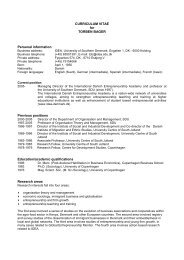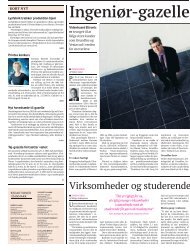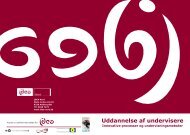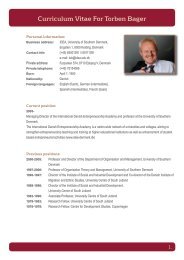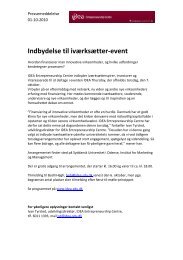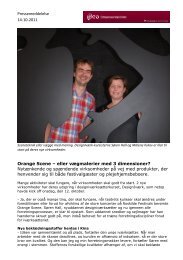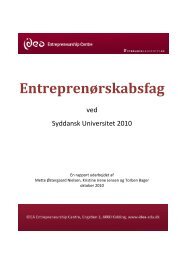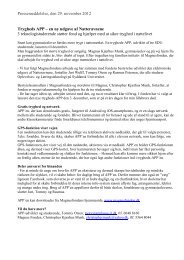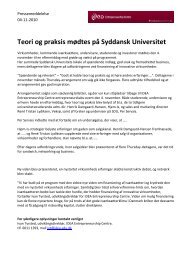Education, Training and Networking for Entrepreneurship in ...
Education, Training and Networking for Entrepreneurship in ...
Education, Training and Networking for Entrepreneurship in ...
Create successful ePaper yourself
Turn your PDF publications into a flip-book with our unique Google optimized e-Paper software.
Appendix with technical specifications<br />
This appendix provides technical notes to the<br />
preced<strong>in</strong>g chapters <strong>and</strong> presents the statistical<br />
models on which figures are based.<br />
Notes to the Danish summary,<br />
Sammenfatn<strong>in</strong>g<br />
Figur A <strong>in</strong> the Danish summary, Sammenfatn<strong>in</strong>g,<br />
is based on Figure 13.1 <strong>in</strong> Chapter 13.<br />
Figur B <strong>in</strong> the Danish summary, Sammenfatn<strong>in</strong>g,<br />
is based on Figure 13.2 <strong>in</strong> Chapter 13.<br />
Notes to Chapter 2<br />
The 39 developed societies are a relatively large<br />
sample of developed societies, the sample is<br />
nearly a census of all the developed societies <strong>in</strong><br />
the world (the developed societies that have<br />
not yet participated <strong>in</strong> GEM are ma<strong>in</strong>ly new<br />
states <strong>in</strong> Eastern Europe such as Slovakia, Estonia,<br />
Lithuania, Ukra<strong>in</strong>e <strong>and</strong> Belarus).<br />
Notes to Chapter 5<br />
Figure 5.1 <strong>in</strong> Chapter 5 is based on the regression<br />
shown here <strong>in</strong> Table 5.2. The unit of analysis<br />
is a developed society. Data are available on<br />
the 39 developed societies participat<strong>in</strong>g <strong>in</strong> GEM<br />
<strong>in</strong> 2002-08 (listed <strong>in</strong> Chapter 2).<br />
Figure 5.2 <strong>in</strong> Chapter 5 is based on the regressions<br />
shown here <strong>in</strong> Tables 5.3, 5.4 <strong>and</strong> 5.5. The<br />
unit of analysis is a developed society. Data are<br />
available on all 39 developed societies participat<strong>in</strong>g<br />
<strong>in</strong> GEM dur<strong>in</strong>g some or all of the years<br />
2002-08 (listed <strong>in</strong> Chapter 2).<br />
Figure 5.3 <strong>in</strong> Chapter 5 is based on the regres-<br />
Table 5.2<br />
L<strong>in</strong>ear regression of opportunities upon <strong>in</strong>stitutional conditions.<br />
The other <strong>in</strong>stitutional conditions had no discernible dist<strong>in</strong>ct effects.<br />
St<strong>and</strong>ardized regression<br />
Probability-value<br />
coefficient<br />
F<strong>in</strong>ancial resources 0.07 0,35 one-tailed<br />
Government policies 0.16 0,18 one-tailed<br />
Commercial <strong>and</strong> legal <strong>in</strong>frastructure 0.32 0,04 one-tailed<br />
Internal market openness 0.32 0,01 one-tailed<br />
Intellectual property rights 0.21 0,14 one-tailed<br />
R 2 = 0.56<br />
N = 39 developed societies<br />
Table 5.3<br />
L<strong>in</strong>ear regression of esteem upon <strong>in</strong>dividualism.<br />
St<strong>and</strong>ardized regression<br />
Probability-value<br />
coefficient<br />
Individualism 0.86 0.0001 one-tailed<br />
R 2 = 0.73<br />
N =39 developed societies<br />
85




